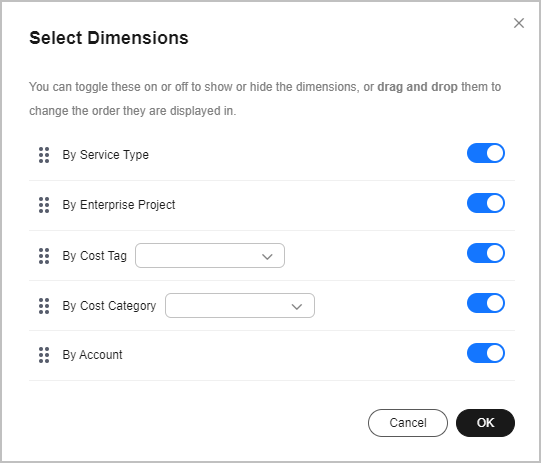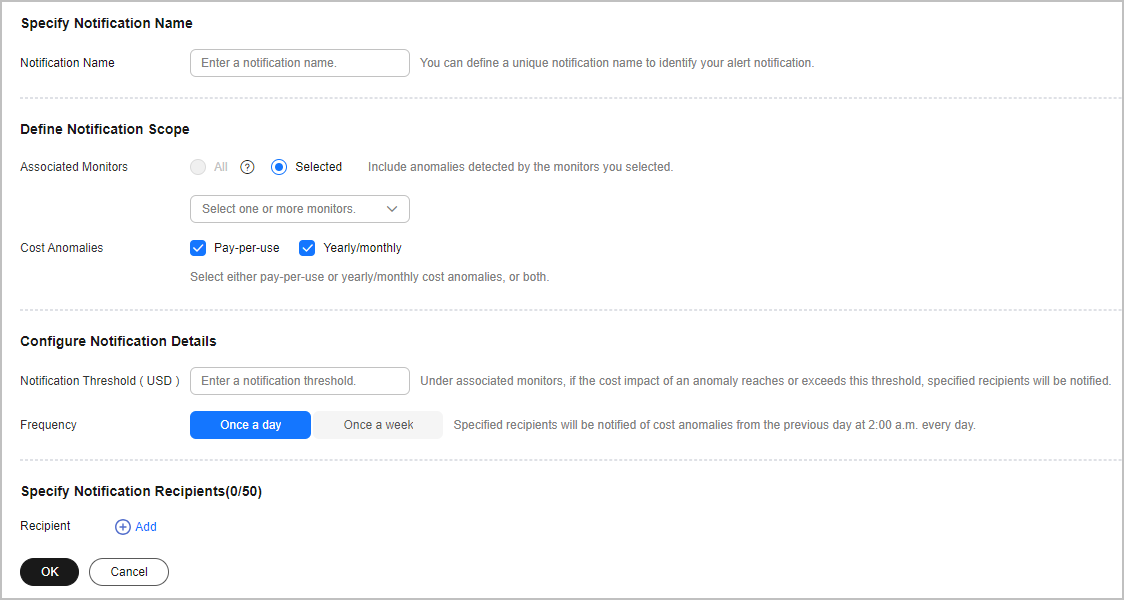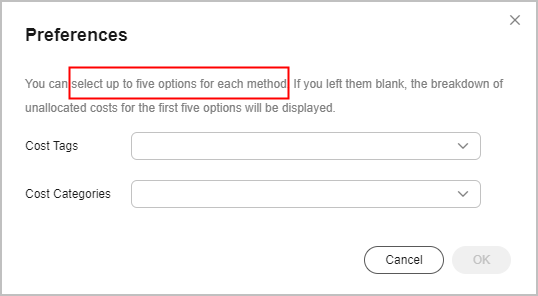Overview (New Edition)
You can learn about frequently used Cost Center functions on the Overview page.
Card |
Operation |
Function |
Reference |
|---|---|---|---|
Cost Management Overview |
Month-to-Date Costs |
Month-to-date original costs (amount due) |
- |
Forecasted Month-End Costs |
Original costs (amount due) forecasted from the beginning to the end of the current month. The costs are forecasted based on your historical costs, without taking into account the current month's actual costs. |
- |
|
Actual Overruns/Forecasted Overruns |
|
||
Cost Anomalies (Last 30 Days) |
The number of cost anomalies detected over the last 30 days |
||
Estimated Monthly Savings |
The total estimated monthly savings for all applicable resources. |
||
Current Month Breakdown (Group By) |
Service Type |
Type of a cloud service. Example: Elastic Cloud Server (ECS) |
- |
Enterprise Project |
The enterprise project selected when you purchased cloud resources. If you have not organized your resources by enterprise project, the following may occur:
NOTE:
An enterprise master account can select enterprise projects by linked account, except the default enterprise project and those not categorized. |
- |
|
Cost Tags |
Used to track costs of resources associated with each other in an enterprise. If you are using a member account associated for unified accounting, you can only use the cost tags activated by the master account. |
||
Linked Account |
The Huawei Cloud account that the cloud resources belong to. If you are using a master account, you can select your associated member accounts to view their cost data. |
- |
|
Cost Categories |
Used to automatically group your costs based on the rules you configured. If you are using a member account associated for unified accounting, you can only use the cost categories created by the master account. |
||
Region |
A cloud service region that provides public cloud service resources independently and serves a large geographical area. |
- |
|
Current Month Trends |
The trend of your current month's costs |
The line chart displays current month costs in the following dimensions:
|
|
Top 5 Costs By MoM Growth |
The top 5 costs by MoM growth. The data can be displayed by service type, enterprise project, cost tag, cost category, or linked account. |
You can toggle the provided switches on or off to show or hide specified dimensions, and drag and drop them to change the order they are displayed in. In addition, you can give default values for cost tags and cost categories.
|
- |
Latest News |
The latest announcements about Cost Center |
This area displays the latest information about function releases and optimizations in Cost Center. You can click Learn More to view the list of all function updates in Cost Center. |
|
Cost Assistant |
Cost management maturity score |
The maturity score of cost management is based on how thoroughly your costs are allocated.
NOTE:
|
N/A |
Recommended Actions |
This area provides recommendations for better cost management based on background data. The recommendations cover cost analysis, budget management, cost monitoring, and cost optimization.
NOTE:
Cost Tags Not Activated: This is displayed if you already have tags attached to your resources but you have not activated them. In this case, you are advised to activate the tags useful for cost allocation to help you analyze and track your costs.
No Alert Notifications: This is displayed if you have cost anomalies detected recently, but you have not configured any alerts for cost anomalies. In this case, you are advised to configure alerts to help you identify anomalies in a timely manner.
|
N/A |
|
Cost Allocation |
Cost Center analyzes your cost allocation by enterprise project, cost tag, and cost category, and rates the cost management maturity based on the optimal allocation method. |
If you select Enterprise Project, the percentage allocated will be displayed. If you select Cost Tags or Cost Categories, the percentage unallocated will be displayed. MoM Change: MoM change = Month-to-date costs – Last month same-period costs You can click Preferences to select cost tags and cost categories, and you can select up to five options for each method. If you leave them blank, the breakdown of unallocated costs for the first five options with the lowest percentages will be displayed.
|
- |
Feedback
Was this page helpful?
Provide feedbackThank you very much for your feedback. We will continue working to improve the documentation.See the reply and handling status in My Cloud VOC.
For any further questions, feel free to contact us through the chatbot.
Chatbot













